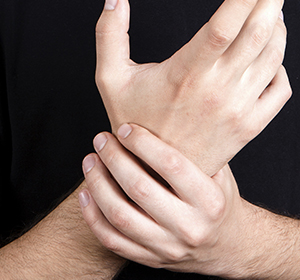What are Neuromuscular Hand Conditions?

Neuromuscular hand conditions refer to disorders of the hands that occur due to an injury or compression of the nerves in the hands or arms that impact the muscles. Neuromuscular hand conditions affect the normal functioning of one or both hands beginning with muscle weakness, pain, numbness, improper coordination, and may lead to paralysis if not treated quickly.
Common Neuromuscular Hand Conditions
The following are common neuromuscular hand conditions:
Carpal Tunnel Syndrome
Carpal tunnel syndrome is caused by compression of the median nerve, which runs along the length of your arm, passing through your wrist into your hand. Symptoms include numbness, tingling, or weakness in your hand and wrist that may radiate up the arm and elbow, and diminished grip strength. Common causes for carpal tunnel syndrome include congenital defects, repetitive motion of the hands and wrists, fractures, sprains, and the presence of a cyst or tumor in the hand/wrist.
Brachial Plexus Injury
A brachial plexus injury is a damage to the brachial plexus - a network of nerves that emerges from the spinal cord in the neck region. The brachial plexus supports muscle movement in the arms and shoulders and provides sensation in the overlying skin. Symptoms may include pain, weakness, a burning sensation, numbness in the arms and shoulder, and loss of movement. It may occur due to a fall from height, a motor vehicle accident, injury from a sharp object, spinal cord injury, or contact sports.
Guyon’s Canal Syndrome
Guyon’s canal syndrome, also called handlebar palsy or ulnar tunnel syndrome, refers to compression of the ulnar nerve as it passes from the wrist into the hand through a space called the ulnar tunnel or Guyon’s canal. A compressed ulnar nerve affects the hand, wrist, and little finger. Typical symptoms include pain, weakness, tingling, numbness, and problems grasping objects. Causes include repetitive hand and finger motion, trauma, blood clots, or ganglion cysts - swellings that most commonly develop along the tendons or joints of the wrists or hands.
Charcot-Marie-Tooth Disease
Charcot-Marie-Tooth disease (CMT) is a neurological disorder caused by a genetic defect. It is characterized by degeneration of the peripheral nervous system, which transmits signals from the brain to various parts of the body and vice versa. Symptoms include muscle weakness, stiffening of joints, hardening of muscles, and loss of sensation in the hands, feet, legs, or forearms.
What are the Treatment Options for Neuromuscular Hand Conditions?
Neuromuscular hand conditions can be treated through a variety of methods that include both non-surgical and surgical approaches.
Non-Surgical Treatment
The first line of treatment includes:
- Medications to minimize pain and inflammation
- Immobilization using a brace, cast, or splint
- Physical therapy to increase mobility and muscle strength
- Occupational therapy to help manage symptoms during daily activities
Surgical Treatment
Surgery is recommended for severe cases if non-surgical management doesn’t provide relief. Surgery may involve any of the following:
Carpal Tunnel Release Surgery
This involves one or more incisions in the palm and wrist area. During the surgery, the transverse carpal ligament is dissected to release pressure off the median nerve and enlarge the carpal tunnel.
Neurolysis
This involves the injection of chemical agents into the nerve fibers to destroy the damaged sensory nerves and minimize nerve pain.
Nerve Graft
The injured part of the nerve is removed and replaced with a nerve from another part of the body.
